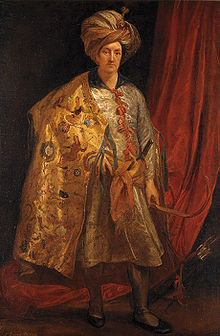Robert Shirley
Sir Robert Shirley (or Sherley; c. 1581 – 13 July 1628) was an English traveller and adventurer, younger brother of Sir Anthony Shirley and Sir Thomas Shirley. He is notable for his help modernising and improving the Persian Safavid army according to the British model, by the request of Shah Abbas the Great. This proved to be highly successful, as from then on the Safavids proved to be an equal force to their archrival, the Ottoman Empire.[1]
Family
Robert Shirley was the third son of
Career
Shirley travelled to Persia in 1598, accompanying his brother, Anthony, who had been sent to
In 1608
Shirley travelled first to the

In 1613 Shirley returned to Persia. In 1615 he returned to Europe, and resided at Madrid. In a pleasingly serendipitous meeting Shirley's caravan met
Shirley's third journey to Persia was undertaken in 1627 when he accompanied Sir Dodmore Cotton the first British ambassador to the Kingdom of Persia,[8] but soon after reaching the country he died at Qazvin, in what is today northwest Iran.[9] After being initially buried there, his remains were later moved from Qazvin to Rome in 1658 by his wife Teresia following her retirement to a convent in the same city attached to Santa Maria della Scala. She died there in 1668.[10][11][12]
In art
There are several double portraits of Shirley and his wife in English collections, including the private collection of R. J. Berkeley and of Petworth House (by van Dyck).[13]
In literature
The exploits of the Shirley brothers were dramatised in the 1607 play The Travels of the Three English Brothers by John Day, William Rowley and George Wilkins.
In 1609, Andreas Loeaechius (Andrew Leech), a Scot living in Kraków, Poland, wrote a Latin panegyric to Shirley entitled Encomia Nominis & Neoocij D. Roberti Sherlaeii. This text was translated in the same year by the English writer Thomas Middleton as Sir Robert Sherley his Entertainment in Cracovia.[14]
See also
Notes
- ISBN 1851096728; p. 544
- ^ Pennington 2004.
- ^ Raiswell I 2004.
- ^ Raiswell II 2004.
- ^ Raiswell III 2004.
- ISBN 0521200946; p. 390
- ISBN 1854378589; p. 54
- ^ At the time crowns of England Scotland and Ireland were in a personal union. However James I and Charles I styled themselves King of Great Britain and Ireland, and so the ambassador represented the interests of Charles as Sovereign of all three countries.
- ^ Firth 1890, p. 417.
- ISBN 084782196X
- ISBN 0774841419; p. 84
- ISBN 1582437742; p. 323
- ISBN 978-1-85437-795-1; pp. 52–55.
- ^ Daniel J. Vitkus. Intro. to "Sir Robert Shirley his Entertainment in Cracovia". In Thomas Middleton: The Collected Works, ed. Gary Taylor and John Lavagnino (Oxford, 2007); pp. 670-72.
References
- Pennington, Janet (2004). "Sherley, Sir Thomas (c.1542–1612)". doi:10.1093/ref:odnb/25435. (Subscription or UK public library membershiprequired.)
- Raiswell, Richard (2004). "Sherley, Sir Thomas (1564–1633/4)". doi:10.1093/ref:odnb/25436. (Subscription or UK public library membershiprequired.)
- Raiswell, Richard (2004). "Sherley, Anthony, Count Sherley in the nobility of the Holy Roman empire (1565–1636?)". doi:10.1093/ref:odnb/25423. (Subscription or UK public library membershiprequired.)
- Raiswell, Richard (2004). "Shirley, Sir Robert, Count Shirley in the papal nobility (c.1581–1628)". doi:10.1093/ref:odnb/25433. (Subscription or UK public library membershiprequired.)
- Firth, Charles Harding (1890). . In Stephen, Leslie; Lee, Sidney (eds.). Dictionary of National Biography. Vol. 23. London: Smith, Elder & Co. pp. 416–418.
Further reading
- Chisholm, Hugh, ed. (1911). . Encyclopædia Britannica. Vol. 23 (11th ed.). Cambridge University Press. p. 990.
- Raiswell, Richard (2004). "Shirley, Sir Robert, Count Shirley in the papal nobility (c.1581–1628)". doi:10.1093/ref:odnb/25433. (Subscription or UK public library membershiprequired.)
- Lee, Sidney (1897). . Dictionary of National Biography. Vol. 52.
|
